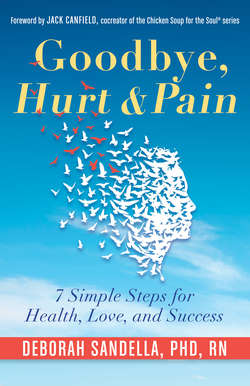Читать книгу Goodbye, Hurt & Pain - Deborah Sandella - Страница 15
На сайте Литреса книга снята с продажи.
KRIS'S STORY: WHEN EMOTIONS GO UNDERGROUND
ОглавлениеKris is a vital forty-nine-year-old manager. Married with two young adult children, she and her husband Rich are filling their empty nest with lots of playfulness. For her birthday, he buys her a beautiful, pink mountain bike, and they head to Moab for an exciting adventure. The sun is shining; the trail is wide open. And then it happens: Kris hits a bump and goes flying. Fortunately, her head is protected by her helmet, but her left leg is shattered on impact. Seeing her tibia poking through the ruptured skin causes her and Rich to grow faint, until Rich comes to his senses and calls for emergency help. Thank God there is cell service.
At the small hospital nearby, Kris lies on a gurney swimming in anxiety when the doctor appears: “Don't worry, Kris, we'll get you stabilized and then send you to Salt Lake for surgery where they have better resources to repair the complexity of this break.”
Hearing these words, Kris's anxiety ramps up, and her mind races with unanswerable worries: “Will I be okay? Will I walk again? Will I have a limp? What's going to happen? If only I had seen that rock on the trail. I can't believe it. Is this really me lying in the ER? Could I be dreaming?”
As the intensity of her concerns increase, so do her symptoms. Her blood pressure drops, and her chest constricts and tightens. She begins to quiver, and her breathing stops. Panicked like a swimmer inhaling water rather than oxygen, she feels she is dying. “Help me, help me, somebody help me!” she screams silently, feeling like she is in one of those dreams where you try to yell and can't!
The ER staff recognizes this is not a panic attack, but something more serious, and quickly treats her for life-threatening anaphylactic shock. As her symptoms recede, she learns she has experienced an allergic reaction to one of the medications.
The next day, Kris is taken by ambulance to a medical center in Salt Lake City. Her surgery is successful, and after a few weeks of rehab, she is discharged home. It soon looks like she is healed and back on track—until she returns to her job and quickly slips into severe depression. For no apparent reason, she is unable to work and her previous enjoyment of life is gone. She goes on antidepressants, yet the depression does not lift.
When her husband Rich contacts me for an appointment for Kris, he sounds desperate. It has been months since she's been off work and nothing is helping; in fact, nothing is changing the least bit.
As Kris sits with closed eyes, she senses a weird feeling in her stomach. Focusing attention on it, she describes it as a black swirling inside that is trying to suck her in and she is afraid of disappearing.
I ask Kris's imagination to call in an image of someone to be a comforting and safe traveler with her on this journey, and her mother shows up. With Mom, she feels safe to bravely move into the black vortex and ride it around and down to the source. As they swirl downward, Kris begins to feel intense dizziness and nausea. Surrendering to the feeling, she and Mom glide down until they hit bottom in an image of the first ER room where she almost died. Watching herself in the scene, she sees Kris lying on the gurney with a broken leg and eyes frozen wide in terror.
Gazing into her own eyes, she begins to cry, even sob:
I thought I was dying . . . I thought I'd never see my kids again . . . Never again to enjoy the beauty of the mountains and sunshine. I thought it was over—I thought my life was over. If I tried hard enough maybe I could hold on—but I couldn't—my chest was getting tighter and tighter and I couldn't breathe. No matter how hard I tried, I couldn't force in another breath. I was dying.
Moving her attention into this image and bringing her mother with her, Kris hesitantly looks out of these terrified eyes and senses the feeling of dying. She moves into this emotional experience as if it were today, and her awareness sits in it, as it organically recedes after a few minutes. Soon there's room for remembering the reality of her physical recovery. Slowly and naturally the frozen feeling of dying melts, and her appreciation for life returns. The feeling of being stuck in a horrible memory has been brought forward, allowed, and organically released. Life has come back!
After this deeply visceral expression of terror, Kris's symptoms of severe depression disappear, and she gradually returns to her job and her life. She finally feels the gratitude for surviving the biking accident she couldn't authentically experience while she was emotionally stuck between life and death. The previously stuck memory has been integrated, and she is present again.
Kris's story demonstrates how unprocessed intense emotion goes underground and creates a subconscious block even when the original traumatic event resolves. Furthermore, her journey shows how health can be regained as soon as the original event is integrated in the mind, heart, and body.
